Preamble
Religion is a soul for me, and I cannot sacrifice it!
– Thought of Sambhaji Raje Bhosale
Do you know of any king or queen who had clear thinking, wise governing strategies, and was the perfect ruler? Who exuded an indomitable personality and was hard as well when it comes to religion and justice. Chhatrapati Sambhaji Raje was the only person who suits with all the above words.
After the sudden death of his father, he became the Maratha king. His father, Shivaji Maharaj, was the founder and first great Chhatrapati of the Maratha Empire.
Sambhaji Raje Bhosale was the full name of Chhatrapati Sambhaji. He was often called as Shambhu Raje was one of his popular Marathi names.
Indian people glorified him with the title “Dharamveer” because of his devotion, love and sacrifice made for Hindu Dharma.
People believed the most powerful Maratha king after the reign of Chhatrapati Shivaji Maharaj.
Brief Information
|
Information
|
Details
|
|
Identity
|
Second Great Chhatrapati of Maratha Empire
|
|
Reign
|
July 20, 1680 CE, to March 11, 1689 CE
|
|
Birth
|
Date: May 14, 1657 CE, Place: Purandar fort, Maratha Empire (Now in Pune district, Maharashtra)
|
|
Coronation
|
Date: July 20, 1680 CE, Place: Panhala fort
|
|
Parents
|
|
|
Wife
|
After marriage name: Yesubai OR Before marriage name: Jivubai Shirke
|
|
Childrens
|
|
|
Successor
|
Chhatrapati Rajaram
|
|
Death
|
Date: March 11, 1689 CE, Place: Tulapur, Mughal Empire (Now in Pune district, Maharashtra, India), Age: 31 years
|
Birth
On the date of May 14, 1657 CE, this great king was born at the fort of Purandar. He was the son of the great Chhatrapati Shivaji Raje and his first wife, Saibai.
Saibai was the elder after the grandmother of Sambhaji Raje, Jijabai. Due to being the eldest and first wife of King, Saibai was chief queen.
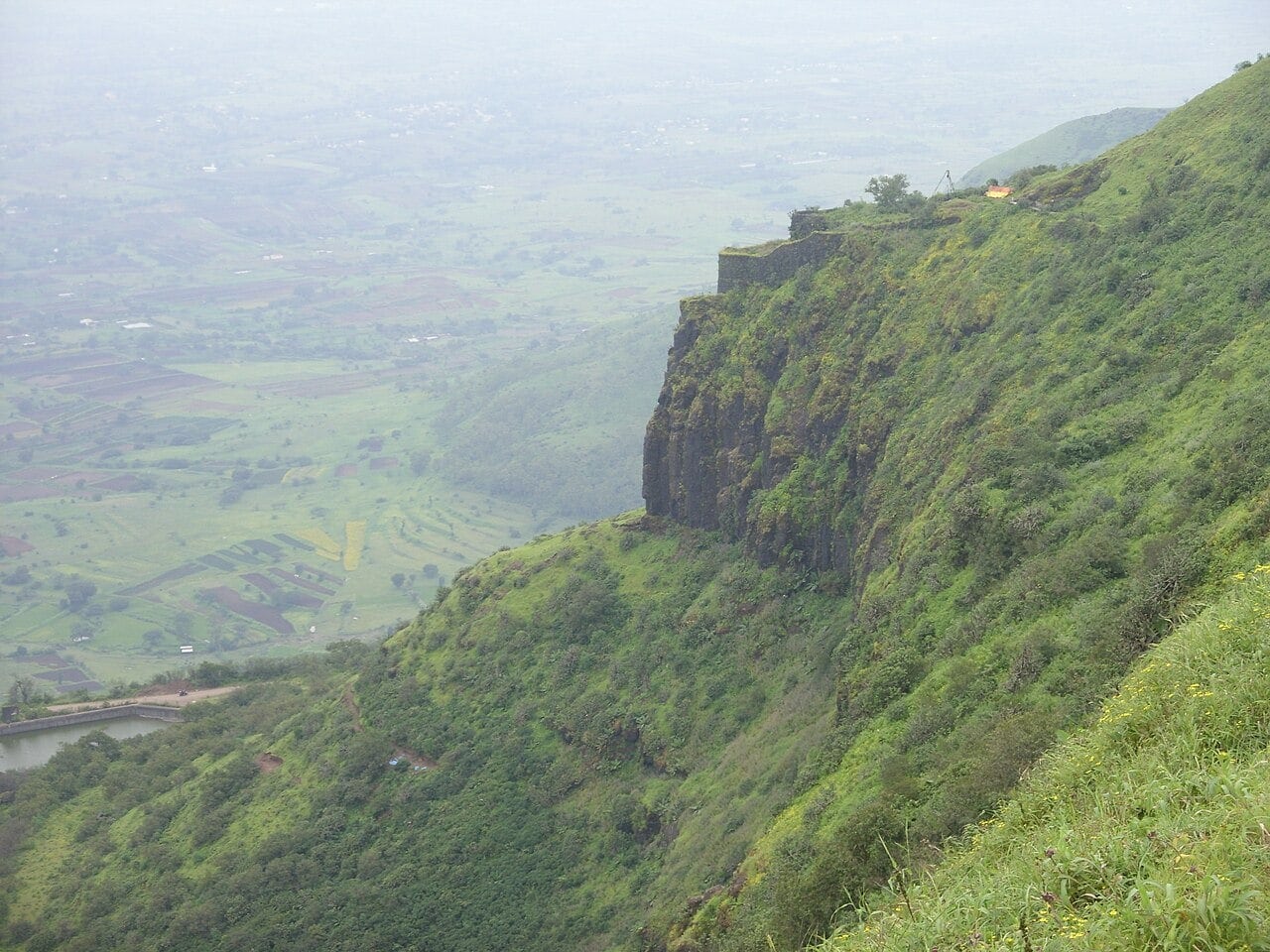
Childhood of Sambhaji Maharaj
When he was two and a half years old, his mother passed away. The reason behind her death was not clearly mentioned in records.
Then, Jijabai took the responsibility of the child Sambhaji. Obviously, as a royal mother, she had the capability to develop a second Chhatrapati.
Sambhaji Raje was not only close to his grandmother, but he was also close to his grandfather, Shahaji Maharaj.
Jijabai ensured Sambhaji grew up in the right way, and with good values. She taught all principles and duties as a prince and future king.
For teaching subjects and developing his overall personality, she appointed pundits. They used to teach him various subjects, including the Sanskrit language.
She added priceless values to the life of child Sambhaji.
Sambhaji grew up as a responsible young prince and hence gained a lot of bravery and confidence in his work.
After sad demise of Shivaji Maharaj, he inherited the throne of his father. He became the second great Chhatrapati of the Maratha Kingdom.
Family of Sambhaji Maharaj
In the family of Sambhaji Maharaj, there were numerous members if we include all of his step-mothers and their children. This complex family structure often led to power struggles and conflicts within the royal household.
Though his brother Rajaram Maharaj was in favor of Shambhu Raje, His mother Soyarabai always wanted his son to became next king. But I think its natural tendency of every mother.
However, it is important to note that despite these internal challenges, Sambhaji Maharaj was able to maintain a strong reign and successfully lead his forces in several battles against the Mughal Empire.
You may be also interested in following article:
Inspirational Icons: Discover the Extraordinary Lives of Indian Freedom Fighters
Political Involvement at an Early Age
Treaty of Purandar – Connection with Sambhaji Maharaj History
As the topic is close to the reign of Shivaji Maharaj, but the history of Sambhaji Maharaj was also connected to it.
During the Purandar treaty, Jai Singh told Shivaji Maharaj to promise to meet Aurangzeb. He also asked him to bring his son, Sambhaji Raje, to the Mughal court in Delhi.
Under that promise, Sambhaji Raje also had to serve the Mughal durbar.
As a result, Sambhaji Raje got into politics at an early age. But because of that he became able to understand the political strategies.
His Character
There is a lot of bad content that gets viral, obviously because negative content often draws attention.
I just want to say a line about his character. Sambhaji Raje had no second lady in his life. At his time, second marriage was really common.
Also, as he was from the royal family, at that time it was necessary to have multiple sons for the inheritance going on. Chhatrapati Shivray actually asked him for a second marriage, but he refused. Then, Shivray urged him, but he could not convince Sambhaji Raje for marriage at all.
He liked to keep home and work separately.
So, you can imagine how pure his character was.
Although, Shivray kept Sambhaji Raje at Panhala for under house arrest. But they did not have conflict in between.
Apart from that, we can see many stories that are in vogue publicly that are totally misleading his personality.
During his reign, he became the target of Brahmanical society because of his strict administration. Apart from it, the society worked very hard to worsen the character of Chhatrapati Sambhaji.
Therefore, the history of Chhatrapati Sambhaji Maharaj has always been controversial.
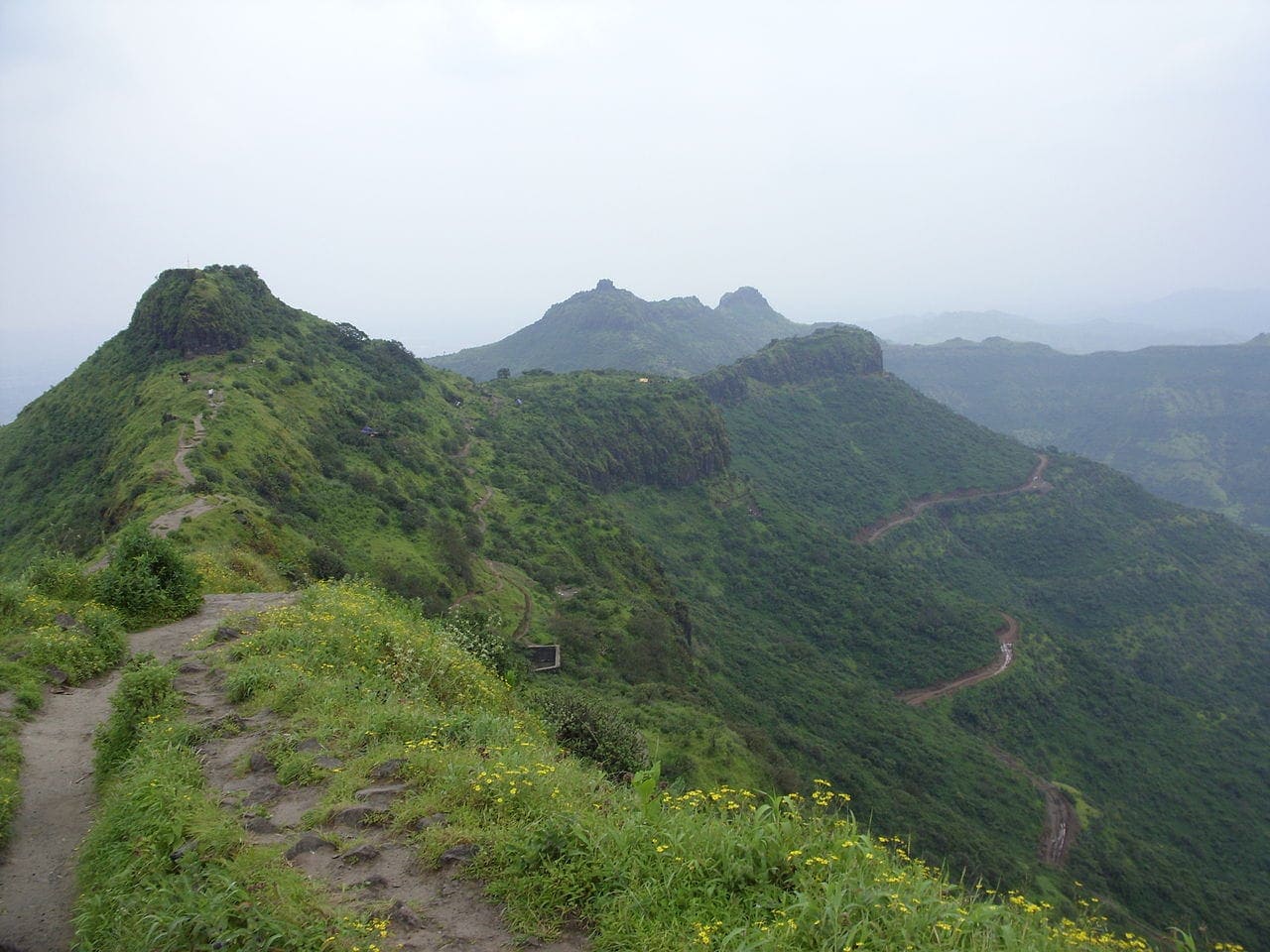
Chhatrapati Sambhaji Maharaj Rajmudra
Whenever a new Chhatrapati was enthroned, they would also change the Rajmudra. When Sambhaji Raje became Chhatrapati, he made a new Rajmudra after the demise of Shivaji Maharaj.
There are few museums in Maharashtra which preserved some letters and legal documents during his reign. These documents have the Rajmudra of Sambhaji Maharaj marked on them.
IndiaVocal reports his Rajmudra as follows:
श्री शंभो: शिवजातस्य मुद्रा द्यौरिव राजते। यदंकसेविनी लेखा वर्तते कस्य नोपरि।।
Above the line of Rajmudra is in Sanskrit language. It means,
The empire of Sambhaji, the son of Shivaji, knows no bounds, just like the sky, and it will rule ensuring safety for everyone.
Lessons By Jijamata
Jijabai taught Sambhaji Raje how to how to give justice in court. He learned leadership skills, military and weapon training, administrative skills, and war tactics. Jijamata assigned the best of teachers, masters and scholars to teach, assist, and supervise of him.
Chhatrapati Sambhaji was inborn with extraordinary intelligent. Apart from it to gain knowledge, he gave his best to be able justice ruler.
Other than that, he also mastered Sanskrit. So courtiers entitled him with the title of “Maha Pandit.” Soon, he was famous for giving justice to people in Maratha durbar.
His fate made him a political target at an early age. Due to which, even though he did not want to accept Mansabdari from the enemy party, he had to accept Mansabdari at Mughal court.
Sambhaji Raje was Bara-Hazari Mansabdar, at an only age of 9 years. You can imagine how much his maturity level was at such a young age.
Personality and Physique of Sambhaji Maharaj
Chhatapati Sambhaji Maharaj Weight and Height
Historians and authors have relied on various sources and books to estimate his height. When we talk about his weight, he was approximately 110 kilograms and possibly up to around 6’2” tall.
In a field like psychobiography, historians try to get insights into the personalities of past lives. So the approximate height is based on pieces of evidence like inscriptions, paintings, coins, clothes, arm suites, etc.
Reading books written by reputable authors can provide deep insights into the various aspects of his physique.
When the British attacked Raigad, fort completely burned due to the bombardment of cannons. So whatever legal documents and other evidences mentioned related to his personality were burned out.
Physique
The history of Sambhaji Maharaj tells us he earned a superb physique. At that time, there were no gyms or any of that stuff. So, he used to do exercises like Pushups (Danda), Squats (Baithaka), Running (Dand), Sun Salutation (Surya Namaskar) etc.
For flexibility, he always preferred Sun Salutation (Surya Namaskara) instead of just stretching the body.
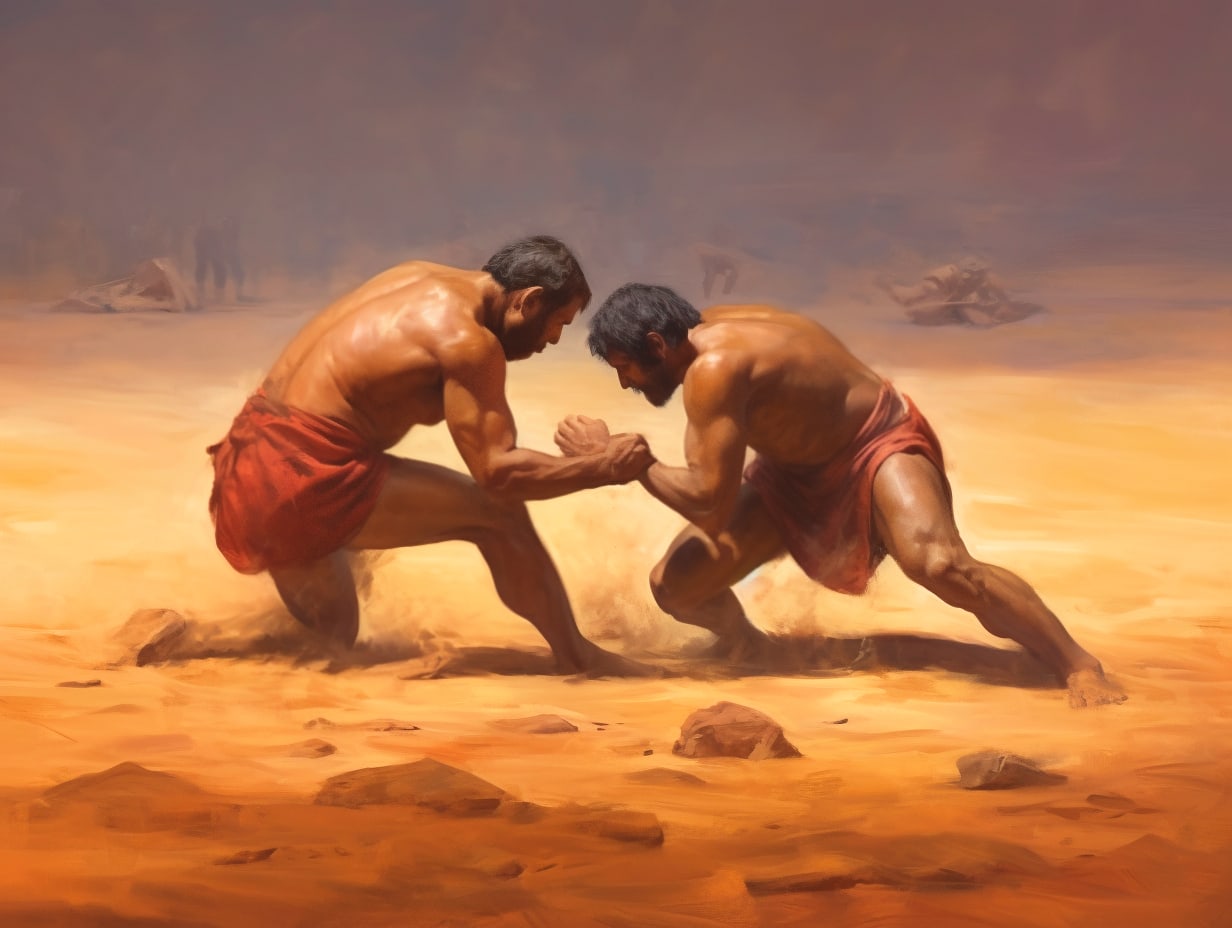
At his time, Kushti/Malla Yudha (Desi Wrestling) was the popular sport. As we don’t have any source to prove it, but, he might also be good at these sports.
After all, his fortitude, efforts for Swarajya and political tactics played a crucial role along with his actual strength.
Books written by Sambhaji Maharaj
Marathi people believe Sambhaji Maharaj was proficient in 14 different languages at 14 years of his age. He could speak Marathi, English, Urdu, Portuguese, Sanskrit, languages of Mughal, all South Indian languages, all Deccan languages, etc.
He wrote three books at this age–Buddha Bhushan, Nakhsheekhant or Nayikabhed, and Sat Shasak (Seven Rulers).
You may also Like to read following biography:
Santaji Ghorpade: A Legacy of Courage
Marriage
Shivaji Maharaj was foresighted and understood the importance of political alliance. At that time, children had used to marry at a very young due to tradition. Probably children marry between the period of 7 to 14 years of age.
Pilgir Rao Shirke was just entered as Military General in the court of Shivaji Maharaj and Jivubai was his daughter. Sambhaji Raje married to Jivubai, later she changed her name to “Yesubai” according to Maratha culture. The marriage of Shambhu Raje was also a political decision taken by Shivaji Maharaj.
Sambhaji Maharaj Rajabhishek
Three months after the death of Shivaji Raje, the coronation ceremony of Sambhaji Raje was held in Panhalagad.
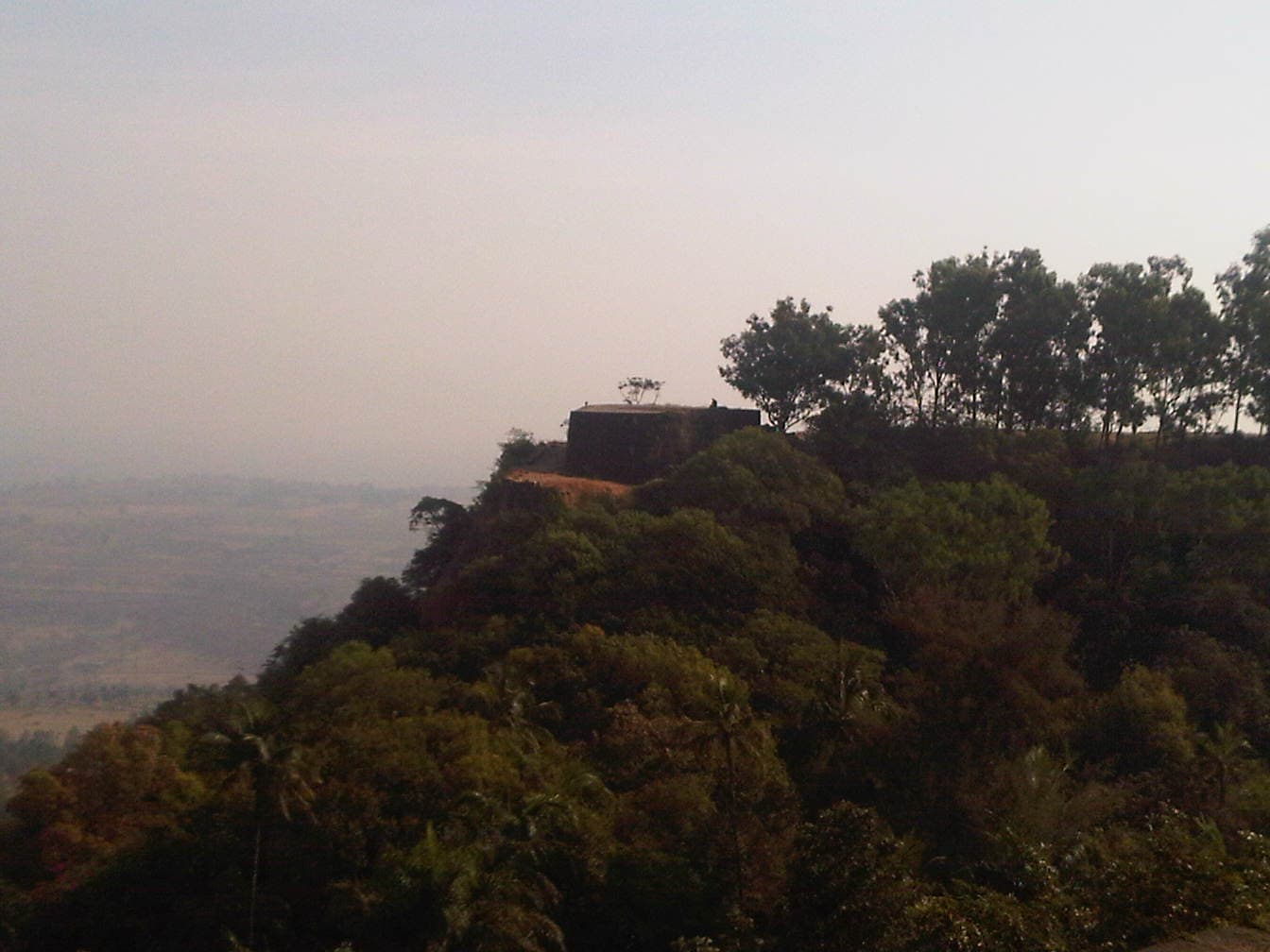
Very little evidence exists detailing about his coronation. Though if one has to describe his coronation, then it should go something like this:
There was a festive atmosphere at Panhalgad. Dignitaries from all over the country came and crowded for the coronation of Sambhaji Maharaj. Fort people and guards living on the fort decorated the entire fort with a Maratha flag, poles, garlands of flowers, and gates with archways.
Of coronation, July 20, 1680 CE, the coronation ceremony started on this morning itself. Brahmin Pandits chanted mantras and anointed Sambhaji Maharaj. Then Sambhaji Maharaj entered the Royal durbar in royal robes, the hall resounded with his cheers. Brahmin Pandits prepared him for the next ritual of coronation. Later, he was placed on the throne.
The Pandits crowned him and bestowed the title “Chhatrapati” on him as Kshatrapala of the subjects.
Like first Chhatrapati, on this day, Sambhaji received the title of ‘Shakakarta’ which signifies ‘author of a period’ in English.
He likewise took the title of Hindavi Dharmodhhaarak during his crowning ordinance service. It means defender of the Hindu confidence.
Later, Maharaj went to Samadhi of Shiva Raya and paid obeisance to him and took his blessings.
After the coronation, the Maharaja addressed all the worshipers in Rajsadra. In it, he expressed his resolve to protect Swarajya and establish Hinduism while trying to complete the sacred work of Swarajya, started by Shiva Raya.
Then, after the speech of Maharaj, the hall erupted with cheers again. All dignitaries wished for Maharaj.
After the coronation, they celebrated a festival for three days at the fort. Maharaj distributed five metals equal to his weight, along with food and other essentials to the people. Fireworks were set off on the night of the coronation, and the fort was bathed in lights.
The coronation of Chhatrapati Sambhaji Maharaj is a golden chapter in Maratha history. Crown Prince Sambhaji Raje was now a Chhatrapati.
When he became a king. Mughal again started attacking on Maratha territories. Whenever a new king was enthroned, enemies were often used to attack and assess the abilities of the new king.
Achievements of Sambhaji Maharaj
Got a capture and control of the Kingdom
Escape from Panhala fort
You would say he was born crown prince, then how would capturing his own kingdom be an achievement?
After the death of Shivaji Raje, Shambhu Raje was at Panhala fort under eye surveillance of fort commander. Some important ministers in the court of Shivray and Queen Soyarabai conspired against Sambhaji Raje.
They tried to prevent Sambhaji from becoming the next Chhatrapati of the Maratha Empire. On getting the information about conspiracy. Sambhaji Maharaj immediately took Panhala fort under his influence.
In that conflict, he killed the fort commander and captured the Panhala fort.
Captured and Punished the Traitors
Hambirrao Mohite was army chief of Shivaji Maharaj and elder brother of Soyarabai. He helped Sambhaji Raje, capturing Panhala fort and getting influence in Raigad Fort.
After they reached Raigad, they took all ministers under his influence. Chhatrapati Sambhaji Maharaj History also let you know the conspirators behind the Shivaji Maharaj death.
Many of the people blamed Soyarabai for the conspiracy behind the death of Shivaji Maharaj. Though she might conspired for making her son next Chhatrapati, it is not true that she was also behind death conspiracy of Shivray.
After that, Shambhu Raje imprisoned Annaji Datto, Peshwa Moropant Pingale and one brother-in-law from the Shirke family.
For justice, he never discriminated between people and his own relatives.
Mysore Campaign by Sambhaji Maharaj
In 1681 CE, Sambhaji Raje began the Southern Mysore campaign against the Wadiyar Dynasty. Chikka Devaraja Wodeyar-II was the king of the Wadiyar Dynasty at that time.
He was one of the very aggressive kings of that time. He had not surrendered to Chhatrapati Sambhaji and attacked instead. In return, Sambaji Raje, with his giant army, fought like storming warriors and won the battle.
Shambhu Raje released Chikka Devaraja Wodeyar on the promise to contribute to Swarajya in the future campaigns. In between 1682 and 1686, Chikka Devaraja Wodeyar contributed during battles.
But, after some time, he refused and made a union with Mughals. As a result, he finally defeated him and captured Mysore in 1686.
Attack on Burhanpur
Chhatrapati Shambhu Raje first attacked the capital of Khandesh Subha (province) of Aurangzeb, named Burhanpur in 1680 CE. In the Chhatrapati Sambhaji Maharaj History, this attack helps a lot in future campaigns.
The intent behind this attack was to reduce poverty and food shortages in the Maratha Empire. The Marathas received huge Mughal treasures in this attack.
In the history of Sambhaji Maharaj, this attack of Burhanpur was famous as Sambhaji Raje defeated Mughal forces with 20,000 troops.
The Marathas received huge Mughal treasures in this attack. Akabar-II was the fourth son of Aurangzeb, who rebelled against the Mughal Empire and went to Aurangabad for further planning.
Aurangzeb also went there and defeated his son and his troop. Hence, Akabar-II had to go out from there. After the defeat of Akabar-II, he had to take shelter of Sambhaji Raje at Raigad.
Fort of Janjira
Murud Janjira was an unconquered fort in the history of India. It was situated in the Indian Ocean. The Navy chief of Sultan Nizam Shah, Rajaram Rao Patil, built the fort of Murud Janjira. Its construction was completed in the 16th century. The fort has a total area of around 22 acres.
The story behind how Siddhis captured the Janjira Fort
Janjira fort has its own water resources inside with enough land. Therefore, people inside the fort can survive for as long as they want without going outside the fort.
After Rajaram, Rao Patil constructed the Janjira fort. He declared himself an independent king. Sultan Nizam Shah appointed Piram Khan as the new Navy chief.
Nizam sent him with enough military and ammunition. But Piram Khan knew we could directly attack and win the fort. That is the reason he went inside the fort in the disguise of a trader.
He impressed Rajaram Rao Patil, so he allowed him to stay and invited him to become a part of the celebration.
At that incident night, every guard was drunk. So, taking advantage of the situation, Piram Khan opened the gate of a fort. Hence, his military got inside easily and victory became a piece of cake.
Interesting Facts of Janjira Fort
- The Murud Janjira is the strongest fort in the Indian Ocean.
- The fort suffered several attacks, but still most parts of the fort are still in good condition.
- Fort designed it in such a way that we cannot see the main entrance till you reach its 40 feet near the entrance wall.
- Murud Janjira has featured naturally with two drinkable water resources. It is considered a wonder of nature because the salty ocean surrounded the fort.
- In the fort, locals are believed to have once there were 572 cannons to defend the fort.
- A special attraction in the fort are three big cannons named Kalak Bangadi, Chavri, Landa Kasam. One cannon, named Kalak Bangadi, weighs 22 tons and is the third gigantic cannon in India.
- The fort once was popular for its excellent defense system. It also has secret ways for in-out.
Battle of Janjira
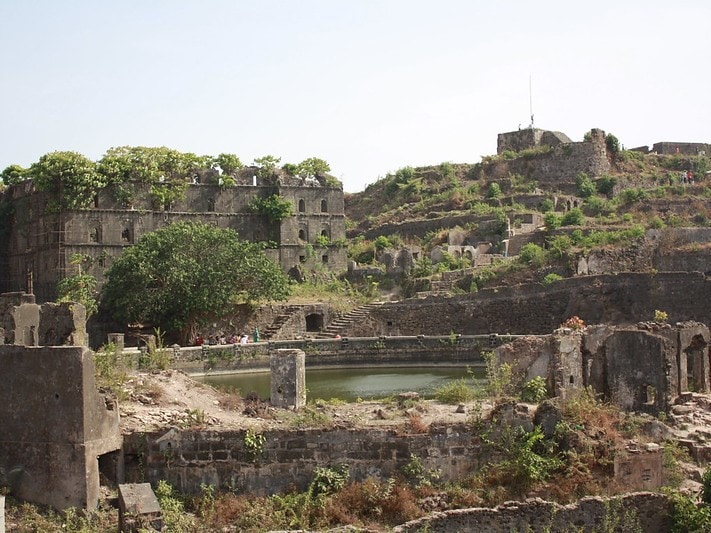
Before Sambhaji Raje, Shivaji Maharaj had already limited the influence of Siddhi to the island of Janjira. Shambhu Raje again attacked on Siddhis of Janjira in 1682.
Marathas did heavy damage to defense of Janjira, and the campaign lasted for almost 30 days. Marathas not broken the defense mechanism of the castle completely.
Then, the Maratha army attacked with the help of building a causeway from shore to island.
Unfortunately, before the attack of Marathas, Siddhis made an ally with Mughals.
As a result, when Sambhaji Maharaj attacked the Siddhis of Janjira, the Mughal army attacked the fort of Raigad to distract him from Siddhis.
As he was very close to winning the battle. But he urgently needed to go back to Raigad Fort for a counter-attack.
After that, the remaining Maratha troops failed to succeed in that mission. Two battles as this battle was the only campaign in the History of Sambhaji Maharaj in which he wasn’t completely succeeded.
There were only two battles that he ever failed during his lifetime. That battles are:
- Battle of janjira
- War at Sangameshwar
Because he wasn’t win the battle, but was not totally lost. On the other hand, he made great damage to Siddhis. During the Janjira campaign, Sambhaji Maharaj built the Padmadurg fort northeast of the Janjira fort.
Attack on Portuguese Forts and Colonies
After an unsuccessful attack on Siddhi, Sambhaji Raje sent his military commander to capture Anjediva fort of the Portuguese.
Maratha thought to convert that fort into a naval base to build new warships and garrisons. But the Chief Commander General failed because of some reasons. So, he returns from Anjediva fort back to Raigad.
Sambhaji Maharaj in Portuguese campaign
Then, Sambhaji Raje went there and continued that mission. He captured all colonies and forts of the Portuguese.
He made the situation for the Portuguese so horrible that they had to run away from Anjediva fort to Cathedral.
In the Cathedral, they hide themselves in the underground vault of the Church where they prayed for their liberation. Portuguese were helping Mughal in trade and allowed them to pass through their region.
The major goal of Shambhu Raje in that mission was to break the union of Mughals and Portuguese. His History is crucial to understand the relationships between Mughals and Portuguese.
Read the Heroic Real Life following Story of Peshwa of Maratha Empire:
Bajirao the Unconquerable: Explore the Heroic Tale
Capture of Shambhu Raje: Worst Event in Maratha History
In 1689, Sambhaji Maharaj planned to throw out the Mughal completely from Hindustan. Therefore, he arranged a meeting at Sangmeshwar.
There, he called all his commanders. Brother-in-law of Sambhaji Maharaj, named Ganoji Shirke, made union with Mughals.
Ganoji was so greedy and wanted Watandari (Maratha Land) from his kingdom. But, Sambhaji Raje straightly rejected his demands to give Watandari.
Ganoji Shirke has exposed all the hidden routes of Sangameshwar to Mughal commander Mukkarabkhan.
At that time, Sambhaji Raje was with his Brahmin friend and advisor “Kavi Kalash” and with some trustworthy people because that meeting was so confidential.
When he was about to leave the village, suddenly, all Mughal troops surrounded him and along with other commanders. After that, his last battle began.
Sambhaji Maharaj was one of the Courageous Freedom Fighters in the History of India.
Last Battle of Chhatrapati Sambhaji Maharaj
All Maratha Chieftains fought with a huge Mughal army. Literally they spill bloodshed till their last breath. Because of the number difference in troops, they captured Shambhu Raje and his close friend Kavi Kalash on 1st February 1689.
At that time, Sangameshwar was under the Maratha Empire, so there were Maratha posts (checkouts to charge tax from traders).
Ganoji Shirke handled that checkpoint saying, both are diamond smugglers arrested by him. After crossing all check posts, Zulfikar Khan was ready with 20,000 Mughal troops.
Some historical theories believe that Zulfikar Khan directly took him to Tulapur. There, Mughal tortured him and finally executed him.
Other theories show that torture has happened in several places. Because the Mughals used to change places because of security.
Because during the reign of Sambhaji Maharaj, Marathas had enough resources and an army. So they could attack to rescue their king.
Zulfikar Khan, along with troops, took Chhatrapati Sambhaji Bhosale and Kavi Kalash far away to Bahadurgad via the Karad-Baramati route.
The history of Sambhaji Maharaj was inspiring as he teaches us we should love our religion and should not change like clothes.
According to Sambhaji Raje, religion means faith. When we change religion, we become unfaithful with our existing religion.
Last Days at Tulapur
Aurangzeb behaved very much inhumanely with both of them. Aurangzeb humiliated Sambhaji Raje and Kavi Kalash by binding them to Camels, with head down position.
Then, Mughal troops threw stones, mud, etc. to feel ashamed, both tolerated all with chanting “Jagadamb, Jagadamb” (name of their family god).
Conditions of Aurangzeb
Aurangzeb actually wanted to mortify both of them. After that, Sambhaji Raje took to the court of Aurangzeb. There he kept 3 conditions in front of Sambhaji Maharaj to be live:
- Hand over all Maratha forts and secret treasures of Maratha Empire
- Disclose names of Mughal traitors, which were officers in the Mughal court
- Accept Islam religion
Sambhaji Raje rejected all of these conditions. Then, Aurangzeb offered many attractive greedy things to break the pride of Sambhaji Raje, but he refused all times.
As, Sambhaji Maharaj refused all conditions. Finally, Aurangzeb started ordered to torture him to break his patience and forced him to accept the Islam religion.
Repeated Torture
According to some records, his torture was so frightful and was described as below:
Mughals plucked out his nails with tongs. Cut his fingers one at a time. Held his tongue in tongs then cut it out. Then peeled out his skin, plucking out his eyes with hot red rods.
At last cut his both hands one by one. Finally, beheaded and then tearing down back to front by weapon.
After each torture, Aurangzeb asked him to accept Islam, but he refused every time.
Aurangzeb used to go into prison in hope he would agree once. But that time never came and torture carried on for several days.
Same torture also did to his friend Kavi Kalash.
At the end, Mughals threw pieces of their bodies of both at the confluence of Bhima River, Tulapur.
Some people of society tried Chhatrapati Sambhaji Maharaj History to counterfeit. Above all, we recognized those authors as renowned writers of Maharashtra.
Sambhaji Maharaj Samadhi
In Sambhaji Maharaj history, it was mentioned that some intellectual Vadhu peoples of the nearby village collected body parts. They sewed them and gave final rites to the body of Sambhaji Maharaj.
Final Ritual by Shivale community
These peoples were later called “Shivale“ which means sewing in the Marathi language. In the Sambhaji Maharaj History, there are so many misconceptions in society.
Due to lack of reading real authorized history and untruth viral due to some wrong people.
Sambhaji Raje showed an unconditional love for the Hindu religion. So, he called the Dharamveer, meaning legend of the Hindu religion, as he was not ready to convert into another religion till his last breath.
Religion policy of Mughals was interesting read to understand the first six Mughal emperors. It will give you an idea of the condition of other religious people during their reign.
Sambhaji Maharaj Statue
The Sambhaji Samadhi is arranged in the vicinity of the Sangameshwar Temple in the town of Tulapur. The Samadhi comprises a magnificent sculpture of the Maratha King Sambhaji Maharaj.
Sambhaji gained the title of Dharamveer, which means the “Defender of Religion”. Aurangzeb built this Samadhi in Tulapur just after the death Sambhaji Maharaj.
Memorizing Sambhaji Raje on Birth and Death Anniversary
Sambhaji Maharaj Jayanti
We also celebrate Sambhaji Maharaj Jayanti every year on the 14th day of May. This occasion aims at remembering and celebrating the epitome of bravery and determination of him.
He ruled the Maratha kingdom with dignity and great bravery. He fought and defended his people with the last of his energy.
Sambhaji remains one of the greatest kings to ever rule the Shivaji Kingdom. His people saw him as a protector. This day, his Jayanti marks the day that this brave legend was born.
People still uphold the culture of celebrating this legend even to date because his achievements and bravery still live within his people.
Sambhaji Maharaj Punyatithi
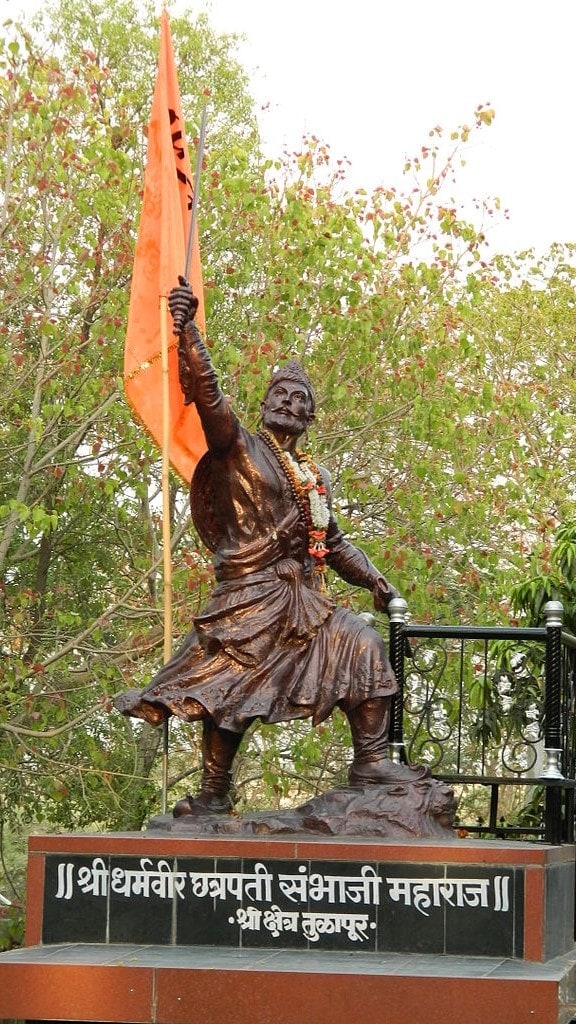
Sambhaji Maharaj showed his strength in various areas during his reign. Whether it is the field of humanism, politics, economics, or religion. He did his best to make positive changes.
Just like any other legendary ruler, he gained honor and gratitude from people, even after his death. Marathi people designated Sambhaji Maharaj Punyatithi day to honor his bravery and achievements.
Indeed, even after being trapped in the grasp of the adversary, they did not do homage to the foe. His bravery and ruling skills remain unmatched up to date.
Punyatithi marks the commemoration of such a valiant lord. Chhatrapati Sambhaji Maharaj died on the new moon of Falgun.
This day marks his passing away. As History puts it out, he passed on the new moon of Falgun. The Marathi people memorize this day as the day of sacrifice.
His Sacrifice played a vital role in converting the Maratha Kingdom into an Empire.
Sambhaji Maharaj history is important in Maratha history as, after his sacrifice, the Maratha troops took a stand against the Mughals. Chhatrapati Sambhaji Maharaj was one of the great freedom fighters of India.
Read the The Epitome of Truth: Story of Raja Harishchandra
FAQ
Who captured Sambhaji Maharaj?
Firstly, Ganoji Shirke exposed information to the commander of the Mughal army, Mukkarabkhan. Then, he sent Zulfikar Khan to Sangameshwar, where he captured Sambhaji Raje with his friend Kavi Kalash on 1st February 1689.
How did Sambhaji Maharaj died?
Chhatrapati Sambhaji, unfortunately captured by Mughals on orders of Aurangzeb, who was his enemy. His death was terrible than our thinking, and it was the most inhuman thing done by Aurangzeb.
How many wives of Sambhaji Maharaj?
Sambhaji Raje married to Jivubai Shirke. After marriage, according to Maratha Royal tradition, her name changed to “Yesubai.” She was the only wife of Chhatrapati Sambhaji.
Did Chhatrapati Sambhaji Maharaj really learn 14 languages?
People often refuse to accept this truth and ask how it is possible to learn 14 different languages? But, it is actually possible because some Indian languages actually have similar phrasing.
Like, if you learn Sanskrit very well, then you can learn Marathi and Hindi in a lesser time. You can take it as my personal opinion, but I think it is well applicable.
I am not saying all languages will be similar but in some languages it definitely has an advantage. It cuts down the learning curve and helps to learn things faster.
Nowadays, children become lazy and not dedicated, and less tolerable to learn to that extent. Because to learn 14 languages, you have to be very dedicated. One should have good pronunciation and be sharp enough to grasp grammar of languages.
I hope you like the Sambhaji Maharaj History. If you are more interested then you can also read other posts on Chhatrapati Sambhaji Maharaj. Please do not forget to share the article on social media and join our list for future updates!
Images Credits
Greenery of Purandar Fort, Credits: Abhijeet Safai
On-site view of Purandar Fort, Credits: Abhijeet Safai
Panhala fort Inside Nature, Credits: BOMBMAN
Janjira fort on site view, Credits: Vikas Rana
Sambhaji Raje Bhosale Statue at Pune, Credits: Raganesh
Vadhu Tulapur – Statue of Sambhaji Maharaja, Credits: Upadhye Guruji
About the Author

Ashish Salunke
Ashish is a skilled biographer and content writer specialized in crafting captivating historical narratives. Through HistoricNation, he skillfully merged his IT expertise with the art of storytelling.
